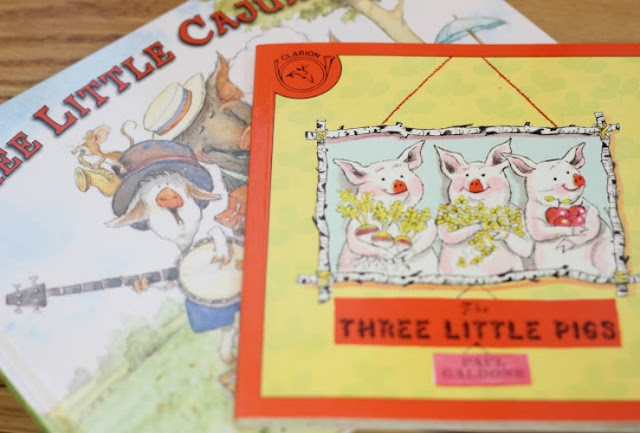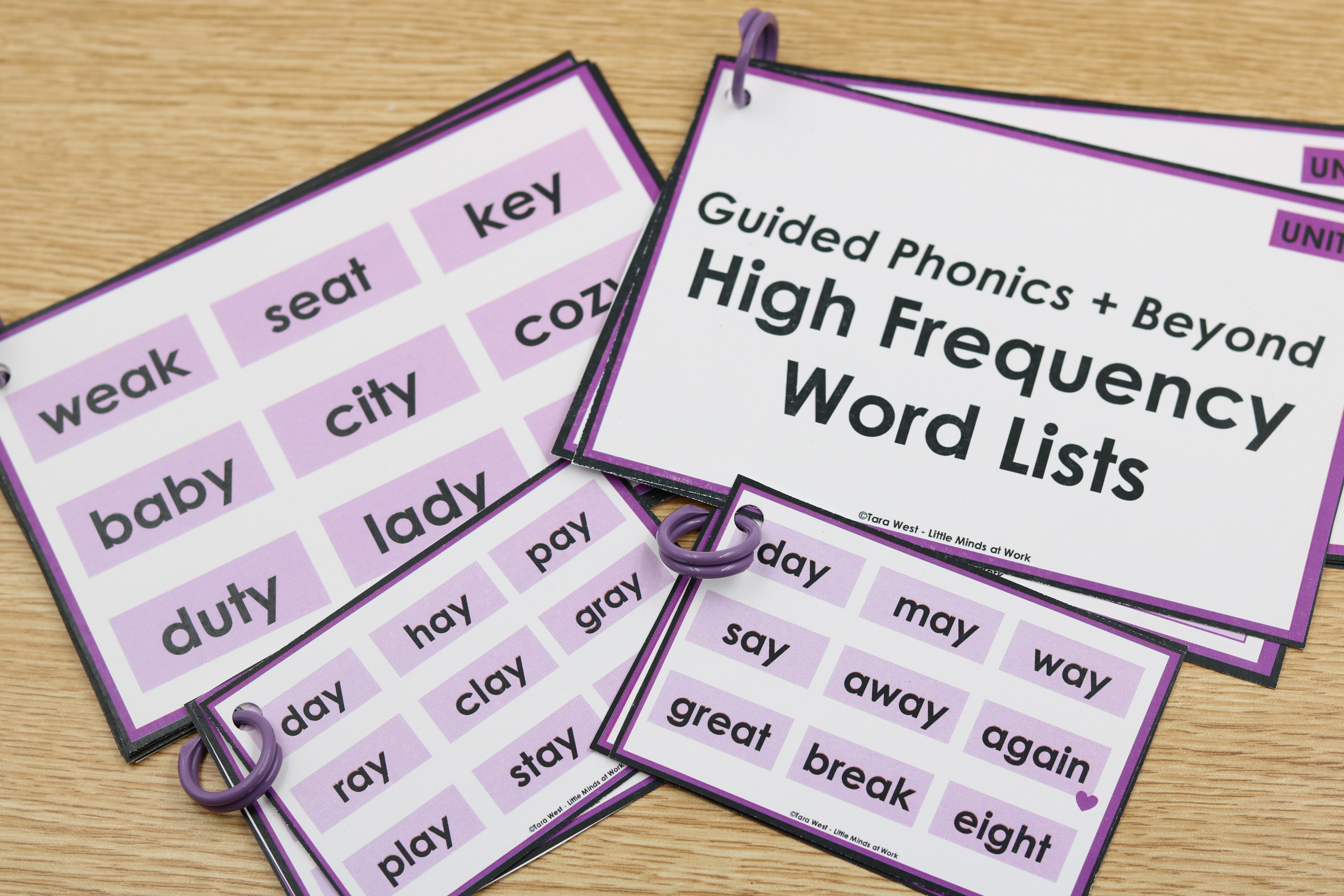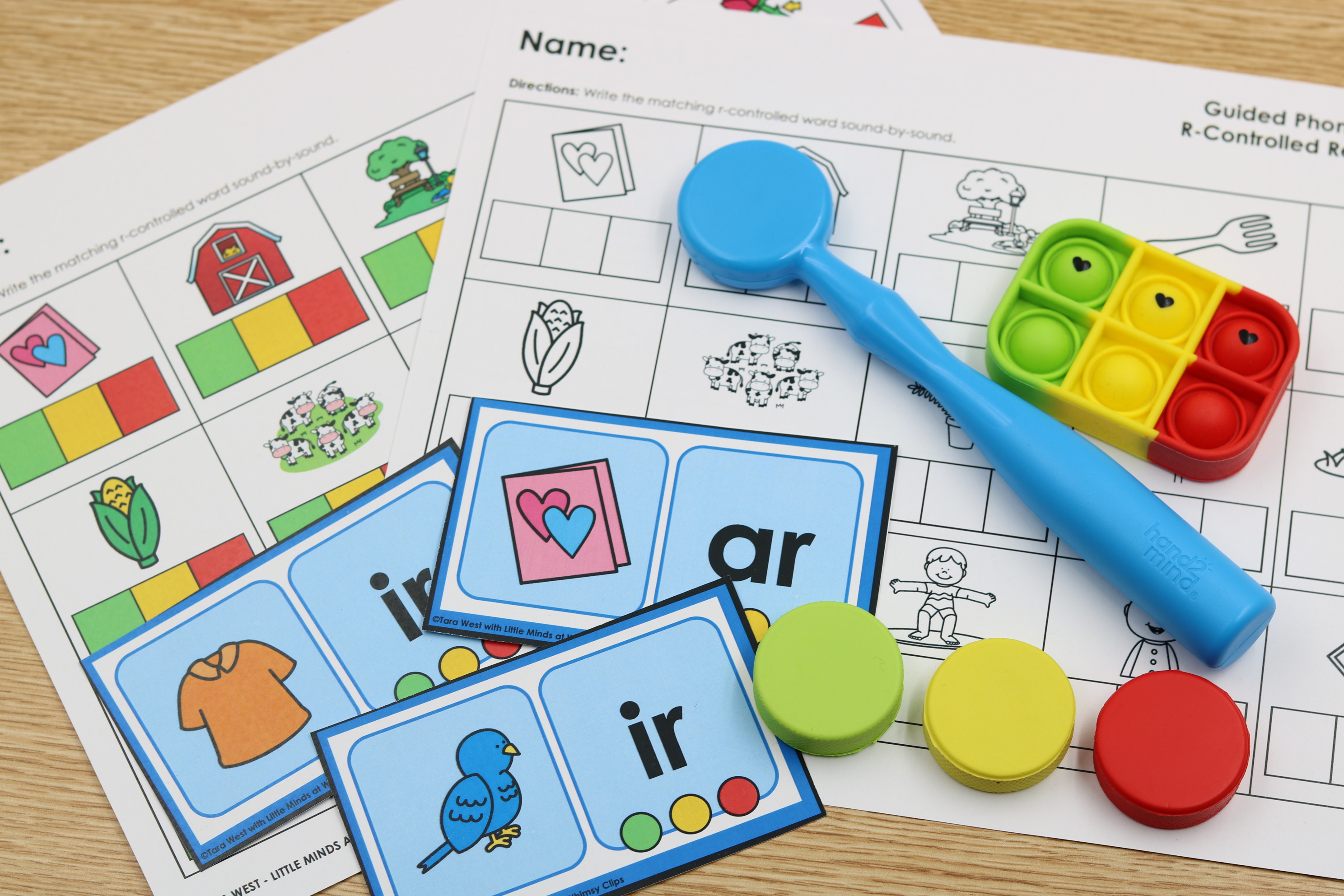Hello, passionate educators and literacy leaders! As you know, phonics instruction is...
Well hello there my sweet teacher friends and hello October! Yes, say it isn’t so…it’s really October! This week the KinderLiteracy Step by Step will look a little different. I know that a lot of you have decided to start to use some of the supplemental units so I have decided to combine all of the fairy tales into this post! I will then cover Fire Safety, Owls, Spiders, and Patriotic (see more on that soon). I thought that this would help to make the bigger picture of the fairy tales as a cohesive unit…then you can decide when in the year it best fits! The fairy tale weeks are part of the RETELL unit! Now, before KinderLiteracy I would have totally told you that I taught the concept of retell to my kindergarten students and I would for sure say that “had it!” However, after breaking KinderLiteracy down to skill based units and really thinking about what I want the kids to get from each unit I can now tell you that after the KinderLiteracy fairy tale weeks the students DO know retell and DO have it down!
Our fairy tales for this unit {all included within KinderLiteracy} were The Three Pigs, The Three Bears, The Three Billy Goats, and The Little Red Hen! We wrap up the retell unit with a fairy tale show for our parents and I’ll explain that more below! Also, know that any/all material I show in this post is part of KinderLiteracy so if you own that bundle you also have all these goodies! Okay let’s get started!
The Three Pigs
For the majority of my close read lessons we focus on a theme each week and place that into our bubble chart! However, for the fairy tale stories we created these story element posters! Here is our poster for this week…
Our vocabulary words + vocabulary cards! The best part of the vocabulary cards are adding in the actions for each week! This week huffed was the prized winner for favorite!
Below are ideas for the vocabulary actions!huffed- act “mad” breathe hard
bundle- demonstrate grabbing a variety of items and tying them up
fortune- make the money symbol by rubbing your fingers together
blaze- use your arms to rein-act flamesEach week of KinderLiteracy you’re encouraged to bring in an alternate text for comparing and contrasting. For the fairy tale weeks I chose alternate versions as the kiddos always enjoy hearing “another side of the story.” This week I brought in The Three Little Cajun Pigs! I LOVE this book! I don’t do the author justice because he is just perfected the Cajun language, but I sure try! You can listen to a version of it HERE.
A huge part of KinderLiteracy’s retell unit is using the retell cards along with the go, slow, stop signs for encouraging students to think about the beginning, middle, and end of the story! Here is a look at the cards!
For this first week we worked as a class to sequence the cards in order using the signs!
The students also had their chance to sequence the cards on their own during a quick end of the week assessment! Below is a look at the assessment sheet under the hover cam. I used this as a way to show the students where the go, slow, and stop signs would fall on their sheets!
Each of the fairy tale weeks we also made retell sticks and retell craft! Below you can see our Three Pigs retell sticks and our three pigs houses made out of milk cartons!
And acting out the story! Melts my heart!
Each week we also did a quick craft! Here are our little piggies! OINK!
And here is all of our hard work on display in the hallway! Love these little piggies!
The Three BearsAnd it’s off to the next fairy tale! We followed suit with the same activities throughout the four weeks of fairy tales so these activities will look similar! I also have provided videos for each of the teacher days for this week! Let’s go!
Day one- Teacher immediately draws students in to the lessons by introducing the weekly theme, students turn and talk to discuss what they know about the theme, teacher charts their knowledge, teacher quickly introduces the skill-based essential question, teacher states the purpose of day 1 {listen for enjoyment}, teacher reads the texts, students turn and talk about new knowledge they gained from the text, teacher charts additional information, students follow-up with a quick exit ticket. This will look slightly different for a fairy tale week* *
Day one’s lesson takes about 15-20 minutes! I accidentally turned off the camera before explaining and releasing the kids back to their tables to do the day one follow-up practice sheet so this lesson was about 15 minutes total! The BIG idea of day one is to draw in your little learners….get them EXCITED about the book! Now with fairy tales this is a little different because you don’t have a “theme” as if you were doing apples or sharks! If you’re afraid the kids will get “bored” each day from the same book- – you will be so surprised! They love it and eat it up….they get to become experts and they truly want to please!
Day two- Teacher revisits the weeks essential question, teacher reviews the knowledge that has been charted, teacher has students turn and talk to state something they learned the day before, teacher states purpose of day 2 {listen and help the teacher figure our unknown words}, teacher reads the text again stopping on the vocabulary words, teacher states definitions and/ or has students turn and talk to discuss their thoughts on the vocabulary words, teacher adds a motion to each vocabulary word, teacher reviews all vocabulary words with student motions, students follow-up with an exit ticket.
The BIG idea of day two is to 1) read the text again and 2) state to teach the kids about context clues and understanding unknown words 3) have students start to use the rich vocabulary in their everyday life! Below you can see the chart we made for The Three Bears!
To make days two and three more manageable for for rereading the pages specific for the vocabulary words or text-dependent questions I will tag them in the book using flags. I will also highlight in my lesson plans which questions/vocabulary words I want to discuss whole-group and which I want to have the students turn and talk.
In my classroom I am able to make a large display for our vocabulary words! The picture cards are part of KinderLiteracy so you’ll have those as well!
Here are ideas for your vocabulary motions!
Trust- make a fist and motion it towards your heart
Frightened- hands to cheeks
Porridge- stir and then eat
Cooled- Motion a spoonful and then blow on it
Peek- make a peep hole with one hand and then peek your eye through it
Below is a closer look of our follow-up exit ticket for day two! These are a quick way for students to show their understanding of the words introduced!
Day three– Teacher revisits essential question, teacher reviews vocabulary words with motions, teacher has students turn and talk to discuss previous learning, teacher states the purpose of day 3 {Think critically about questions from the text- – and use EVIDENCE}, teacher reads parts of the texts that lends to their text-dependent questions, students turn and talk to generate answers for text-dependent questions, students follow-up with practice sheet
The BIG idea of day three is to teach the students how to use the text to answer specific questions. You also want to teach them about using specific evidence from the text to support their answers. How do we know that? How did the author teach us that? You will be able to relinquish more and more the kids as the year progresses!
Below is a closer look of the follow-up practice sheet we did with day! I love these quick “assessments” of student learning!
Day four– Teacher revisits essential question, teacher has students turn and talk to discuss skill-based and life-based essential questions, teacher reviews vocabulary words with motions, if retell book students work with teacher to retell the story using story sequencing cards, teacher reads an alternate text that links to the same theme, students turn and talk to discuss connections from the text, students follow-up with practice sheet.
Not seen in the video was after we had a quick brain break we followed up with the black line practice sheet for this book which was a sequence of events retell!
The BIG idea of day four is to review the learning that has taken place thus far in the week and bring in an alternate text of the same theme!
Below are the two texts I read for this week! Each week of KinderLiteracy it is suggested you bring in two texts…with the text second being any book you have on hand that follows the same theme! 🙂
Day five– Teacher revisits essential question, teacher has students turn and talk to discuss skill-based and life-based essential questions, teacher reviews vocabulary words with motions, teacher leads a discussion for the week’s book/theme, students take weekly skill check, students create weekly craftBelow us a look at our retell craft for this week! For the retell weeks we made retell sticks/crafts, but all weeks of KinderLiteracy have an included craft for the kiddos!
I really like the theme or close read in general to become a big part of our classroom each week so I am always sure to hang up our posters and post our crafts in the classroom or in the hallway! I feel it makes the books even more meaningful as they become a part of our classroom!
I also wanted to briefly discuss this picture! During my close read lesson I like to utilize the information I have about the book around the classroom for the kiddos to see! I think it’s so important that they understand the meaning behind what we have posted around our rooms! Although at this time they are not able to read it all themselves, they will soon enough! You can see me reference the large vocabulary wall, posted essential questions, charter information, and the book that’s always available for the kiddos to look at in the front of our room!
The Three Billy Goats
And we’re off to the next fairy tale! The kids always, always, always love the Three Billy Goats…I mean who can’t? Here is a look at our story elements poster {minus the BME picture cards} we added those the following day. You can see each week we added a new concept to discuss on the story elements posters! As designed by KinderLiteracy …each story element is taught slowly to allow the kids to really grasp the concept before adding on a new skill the following week!
And the weekly vocabulary words and cards! Below are ideas for your vocabulary motions!
Rushing- use one hand to motion a rushing river
Fine- thumbs up
Valley- Use two arms to make a mountain peak and then motion a swooping motion to resemble the valley between
Roared- let them ROAR!!!!
Trampled- use hand and opposite hand to make a stomping motion
Essential questions are posted on the board each week for discussion! Here are the two for this week! I like one literacy skill-based essential question and one life-based essential question! Both questions are mentioned and discussed throughout the week with the hope that the kiddos can clearly answer both by the end of the week!
KinderLiteracy includes a great way to assess kiddos each day post lesson and see how much they are taking from the lesson and allows you to see if they are able to apply it! This is a quick vocabulary exit ticket! The kiddos were illustrating valley and rushing!
Each week we continued with our retell cards! Here is a look at this week’s!
Our retell craft for this week was easy, but oh so fun! The kiddos also made their retell sticks!
And another poster added…
The Little Red Hen
The final week of our fairy take study was The Little Red Hen! Who doesn’t LOVE Little Red Hen?
And our story elements poster for the week!
The weekly vocabulary words! Below are ideas for your vocabulary actions!
Mended- make sewing motion
Snooze- hands under head to resemble sleeping
Cozy- use both arms to motion a snug feeling and then let out a happy sigh
Grind- cup one hand for a bowl and then use opposite hand to resemble a circular motion
Wheat- use two arms to resemble stocks
Our essential questions and the skill-based question was summative to our fairy study! What actually makes a story a fairy tale?
And the retell practice kept on going! True retell experts now! 🙂
For The Little Red Hen we once again made retell sticks to tell the story with!
We also made these ADORABLE hens from Jennifer at First Grade Blue Skies!
So stinkin’ cute!
Fairy Tale Performance
As a way to celebrate our study of fairy tales we help a fairy tale show for our parents! I already had these masks, but there are some headbands included within KinderLiteracy! We practiced and practiced until we were ready!
Each kiddo had a part in the performance and I think the parents loved it! I was so teacher proud!
After the performance we munched on cookies and punch!
I had also had the kiddos save all of the fairy tale retell sticks and retell crafts in a large Ziploc baggie. They were able to pull out the sticks and retell the stories for the parents!
Well, that is a wrap for fairy tales! Also, I mentioned above but all of the material that was presented is included within the units! They really do stop the hunting around that used to occur each week at lesson planning! It’s all in there for you! You can view more about KinderLiteracy HERE. Again, next week’s KinderLiteracy Step by Step will be all about Fire Safety! You can find that lesson in Unit 8 (Supplemental weeks).
Today I have an all new mini lessons, writing video, and freebie! : ) Okay let’s jump right in! You know as your kiddos start to write more…whether this is coloring, labeling, or writing actual words on their paper… there is usually still this notion that after their inital work is completed, they are “done.” For some students this is at the end of your independent writing block, but for a lot of kiddos this is only after 5 or 10 minutes. We will find ourselves reminding them to add more to their pictures… draw more details, label another item on their picture, etc. However, wouldn’t it be nice if they self-monitored when they are actually “done?” Below’s video is a quick mini lesson that addresses this!
In the video you really saw many mini lessons all wrapped into one! We discussed the “We are Writers” chant, what it means to write, starting a simple sentence, and then what we do when we are “done.” You can download the freebie poster by clicking ****HERE.****
Another hard part about those first crucial months of writing time is keeping the kiddos interested and giving them a true purpose along with passion to write! I have always loved giving them a fun writing task that links to their lives at school! This is a fun “school” booklet we love to create at the beginning of the school year! I go outside and take several pictures of the playground, print them, cut, and leave them on the tables for the kiddos to grab one for each day of writing. The glue their pictures down and then write a connecting story! They are all simple sentences but the kiddos are writing! You can snag this freebie booklet below!
At the end of the week we construct our booklets! They glue the cover onto a large landscaped construction paper already folder. We place the pages inside and then I staple along the outside!You can download the freebie story booklet HERE!
In today’s KinderMath Step by Step post I will be covering how to extend your numbers to 10 instruction! Following along the KinderCurriculum pacing guide you are most likely still in unit 3 (Number to 10) of KinderMath! I get a lot of comments and emails from teachers wanting to know how extend numbers to 10 for their students that already know those numbers! It’s really easy to say…“Oh the know their numbers to 10 so I’ll move on!” I caution you to notice carefully the difference between knowing numbers to 10 by simply identifying them and TRULY knowing their numbers to 10. Truly having number sense to 10 would be they can tell you what number is more less, 2 more, 2 less, and be able to explain that number in detail… that would be using their words like, “I know 5 is more than 2 because when I count …5 is 3 more than 2.”
Below I will be sharing some fun ways to really hone in on those numbers to 10! Up first is compare the deck! These cards are part of KinderMath and KinderMath Number Sense. However, you can also snag them for free ****HERE*****! You’ll notice that these cards aren’t your typical deck of cards… they offer the assistance of a ten frame for the students to compare with! You will want to make sure you are not only allowing the card that is “more” to win… but also play where the card “less” wins as well. Have students not just lay out cards and grab the set that is more/less. However, they also both need to participate in a math talk about the cards. “9 is more than 3… do you see with 9 there is only 1 missing dot!”We also love to build sets to show comparison! Allow the students to use blocks or snap cubes to model comparison! For kiddos visually seeing “math” is so crucial! We we give numbers orally it can be difficult for our struggles! Give them a visual and allow them to “see” those numbers!
We LOVE number line up! When working on comparing we make our number line go vertically instead of horizontally! This helps immensely for the kids’ understanding of more/less. The kids can see the numbers being more or less. (Sorry for the blurry picture.) You can download these freebie number line up cards ****HERE.*****
To provoke thought and conversation one day I laid the cards down in a vertical fashion but with 1 at the top. We talked about this and the kiddos decided it would make more sense to place one at the bottom! After we moved all the cards into the correct order we then placed them on our board like above!
I hope you have enjoyed these ideas on expanding your numbers to 10 instruction!
That’s all I have for you today but talk soon!




